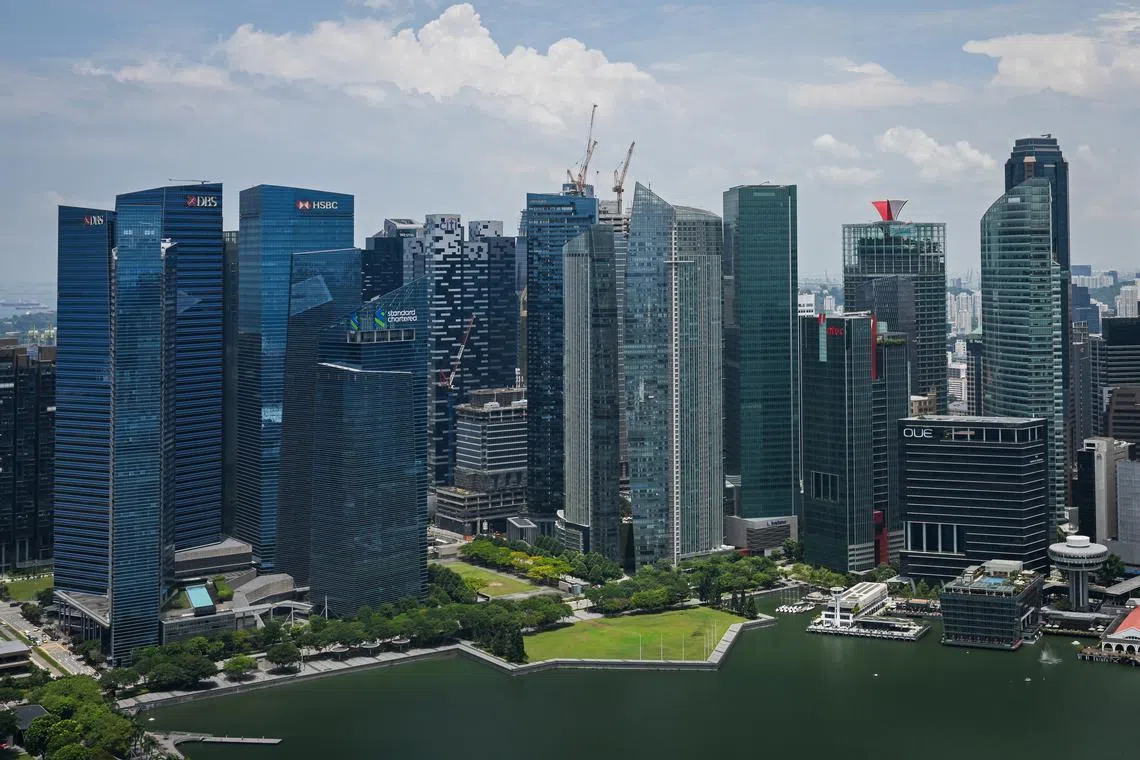Economists keep Singapore’s 2025 growth forecast at 2.6% as trade tensions rise
Sign up now: Get ST's newsletters delivered to your inbox

Geopolitical tensions, including from higher tariffs, are seen as the biggest downside risk to Singapore's economic outlook.
ST PHOTO: SHINTARO TAY
Follow topic:
SINGAPORE - Private sector economists kept unchanged their forecast for economic growth in Singapore at 2.6 per cent in 2025, while citing geopolitical tensions, including from higher tariffs, as the foremost downside risk to the outlook.
That pace of growth will be slower than the 4.4 per cent Singapore clocked in 2024 and is closer to the higher end of the 1 per cent to 3 per cent range
The economists also flagged weaker growth in China and a resurgence in inflation as potential risks, according to the latest quarterly survey of professional forecasters by the Monetary Authority of Singapore (MAS) released on March 19.
Survey respondents also projected economic growth to slow to 2.3 per cent in 2026.
MTI in February had also flagged the risk of higher uncertainty over US economic policies amid escalating trade tensions.
US President Donald Trump has so far imposed a 20 per cent tariff rate on China, as well as a 25 per cent levy on steel and aluminium.
Mr Trump has also threatened 25 per cent tariffs on Canada and Mexico and plans to announce broad reciprocal tariffs
In the latest MAS survey, the most probable outcome for 2025 growth is that it will be between 2.5 per cent and 2.9 per cent, similar to the previous survey.
However, the average probability assigned to this range rose to 46 per cent from 42 per cent in the December 2024 survey.
Geopolitical tensions were cited as the top downside risk by all respondents, unchanged from the previous survey.
The number of respondents citing the risk of weaker growth in China rose to 43.8 per cent, from 42.9 per cent in December.
DBS Bank senior economist Chua Han Teng said it was unsurprising that geopolitical tensions continued to be cited as the top downside risk by all respondents for the second consecutive quarterly survey, given that the Trump administration has ratcheted up and widened its tariff threats to a greater number of economies and sectors.
“Geopolitical tensions, particularly the risks of higher tariffs and possibility of tit-for-tat trade war, will likely remain a key focus for investors in the coming quarters,” he said.
Upside risks to Singapore’s outlook were topped by expectations of more robust growth in China – identified by 60 per cent of respondents. Respondents also pointed to a sustained tech cycle upturn and milder-than-expected trade tensions as key upside risks.
Inflation in Singapore was seen as easing further in 2025 in the survey.
For 2025, overall inflation was forecast to fall to 1.7 per cent from 2.5 per cent in 2024. Core inflation – which excludes private transport and accommodation costs – was projected to drop to 1.5 per cent from 2.8 per cent in 2024.
Both the inflation forecasts were lower than those made in December.
As for the jobs market, Singapore’s overall unemployment rate is expected to stand at 2 per cent at the end of 2025, down from the previous forecast of 2.1 per cent.
While the survey showed most economists continue to expect MAS’ stance to remain unchanged in the upcoming monetary policy review in April, some economists do expect the central bank to signal further easing.
The central bank eased its policy stance in its January meeting, seeking a more gradual pace of appreciation of the trade-weighted Singapore dollar.
Most central banks use interest rates to manage their monetary policy, which is aimed at managing inflation. MAS, however, uses the exchange rate, as the bulk of inflation in Singapore is driven by prices of imported goods and services.
MAS does not directly set the precise level of the exchange rate; instead, it manages the value of the Singapore dollar within a policy band against a trade-weighted basket of currencies of its trade partners – referred to as the Singapore dollar nominal effective exchange rate, or S$Neer.
In the latest survey, 15.8 per cent of the respondents expect MAS to reduce the slope of the S$Neer policy band in the next review due in April. The slope represents the change in the pace of S$Neer appreciation over time.
A reduced pace would mean slower appreciation.
MAS can also strengthen or weaken the S$Neer immediately by shifting the midpoint of the policy band. A lower midpoint would mean slower appreciation.


